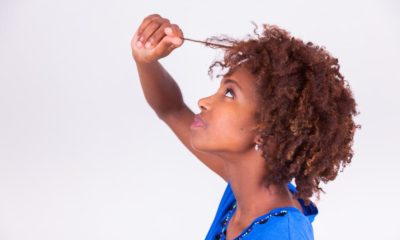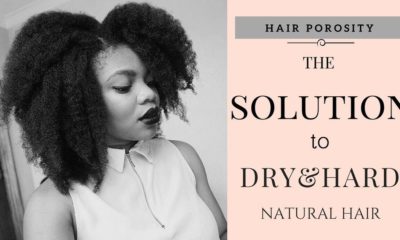Style
Nicole Ezeh: Here Are Some Things You Should Know About Hair Porosity
 Hair Porosity is the hair’s ability to absorb and retain moisture. In Agricultural Science, we were taught that soil porosity is one of the factors in determining a good soil. Loamy soil is relatively porous making it the best soil because nutrients can get into the soil but most importantly, stay in the soil. Clay soil is not porous. Water just sits on top of it. Sandy soil is too porous. Water gets in easily and leaves just as easily.
Hair Porosity is the hair’s ability to absorb and retain moisture. In Agricultural Science, we were taught that soil porosity is one of the factors in determining a good soil. Loamy soil is relatively porous making it the best soil because nutrients can get into the soil but most importantly, stay in the soil. Clay soil is not porous. Water just sits on top of it. Sandy soil is too porous. Water gets in easily and leaves just as easily.
Hair porosity can be determined by different factors and these may range from environmental factors, careless combing, brushing and general detangling routine, dyes, heat damage or it may even be genetic.
There are three types of Hair Porosity:
• Low (LoPo)
• Medium/Normal (No/MePo)
• High (HiPo)
Low Porosity is the type of porosity where the hair’s cuticles are tightly-bound and closed. This is a situation which results in deep conditioning or moisturising and the hair stays the same because this particular porosity-friendly methods were not used. If you have LoPo hair, heat is your friend. Heat is not meant in the form of flat-irons and blow dryers. Steer clear of those as they are extremely harmful to LoPo hair.
High Porosity is the type of porosity where the hair’s cuticles are gaping wide constantly. HiPo hair experiences instant moisturising and instant dryness, because the moisture gets in easily and leaves just as easily. This may lead to moisturising twice or thrice a day. If you have HiPo hair, everything cold and heavy is your friend. Flat-irons also harm HiPo hair by leaving the cuticles more damaged than they were.
Medium Porosity is the type of porosity where the hair’s cuticles are halfway open and halfway closed ie balanced. This is a situation where your hair absorbs moisture moderately and also releases it moderately leading to moisturising every two to three days. Warm air is perfect for this type of porosity, because it maintains the cuticle health.
How To Determine Hair Porosity
There are different ways to determine hair porosity but in this article, the easiest, widely used and fool-proof way will be outlined:
The Water Test
This involves dropping a clean strand of hair into a still cup/bowl of water at room temperature. Clean hair must be used preferably shampooed hair because products and natural hair and scalp oils (sebum) may be coating the hair strand causing the hair to float giving wrong results. Let it sit for an hour. Observe and record your results (sorry, science nerd here).
Precautions
• Don’t use cold water. Room temperature water is 25 degree celsius so lukewarm water is fine
• The water should be still before you drop your hair strand
• Do not touch the strand after dropping it. Drop it in gently.
The Results
• If it floats after an hour, LoPo hair
• If it drops in gradually, NoPo hair
• If it drops in instantly, Hipo hair
It does not matter what your hair porosity is, there are ways/products to rectify the situation. We’ll be looking at normal/medium porosity in this article. Taking care of low and high porosity hair can be tedious so they will be treated in two different articles to avoid information overload.
Normal Porosity hair is the best of both worlds. Everything happens in moderation. The cuticles are normally healthy. The position in which the cuticles lie allows product to penetrate and keep hair moisturized. For the most part, with this porosity type, the hair is shiny, smooth, soft. Liquids or products that penetrate the cuticle, water enters and stays, moisturising your hair.
How To Maintain Normal Porosity Hair
• Moisturise using the LOC method every two to three days according to your hair’s needs.
• Finger detangling gently is best and it should be done on damp hair and with coconut/olive oil to avoid breakage and retain length.
• Hot oil treatments twice a month to keep hair shiny and soft. Use coconut oil, avocado oil or olive oil. These oils penetrate into the hair strands.
• Minimise the use of heat. Allow hair to air-dry instead of blow drying. If you must, blow dry with cool air.
• Use moisturising shampoos, deep conditioners and instant conditioners. Sulphates dry out the hair by stripping off the hair’s natural oils.
• Work in sections when washing, conditioning or detangling your hair to prevent breakage. This takes the headache away when doing your hair.
• Do protein treatments once a month to keep both strength and elasticity in your hair.
• Wash with warm water and do a last rinse with cold water.
This is a very simple regimen to follow for healthy hair. I hope you picked up a few helpful tips from this article. I had to break it down for better understanding.
Photo Credit: Dreamstime
























